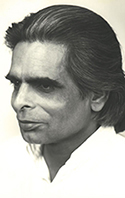To spread the original, universal and eternal truth, path or law of yoga, which remains forever the same in essence, yet always adapts to the time and place. |
|
Mantras can excite the emotions and give suggestions to the mind. Mantras affect both the one who chants them as the one who hears them. The word mantra comes from the Sanskrit "mantrana", which means advice or suggestion. In a sense, every word is a mantra. In our daily life we use words to get everything done, obtain everything we need. Each mantra or word is a sound pattern that suggests to the mind the meanings inherent in it, and the mind immediately responds. According to Ramana Maharshi, repetition of mantras (japa), with attention directed to the source of the sound, completely engages the mind. This is Tapas (penance). The source is not in the vocal chords alone, but also the idea of the sound is in the mind, whose source is self. Thus the practice of mantra repetition is more than a suggestion, a bit of advice or an idea. It is a means of getting in touch with our self. Mantras may be used for religious worship, for japa (repetition), for healing, to help spiritual evolution, for purification, for making offerings and in Mantra Yoga. Some mantras are only chants or expressions of nearness to the Divine. But some saints who were inspired by divine love and unshakable faith used these mantras in their own spiritual practice and their followers afterwards started using those mantras, calling them mahamantras or great mantras. Primarily it is faith which creates the effect of mantras. Melody, intonation, pronunciation, whether silently or aloud, all are important in the recitation of mantras. Moreover, the beat cycle in which mantras are recited is important, but it changes according to the state of consciousness of the one who is chanting. An increase in the speed of chanting increases the speed of mind, heartbeat and respiration. The beat cycle of the mantras affects the emotions. A fast speed sometimes creates a continuous vibration and when it is done in groups it creates a good effect, because the mind works in synchronization with the beat cycle and has no time to fantasize. Fast chanting of mantras exhausts the mind, heart and breath and relaxation comes after the chanting is over. Slowing the beat cycle of mantras also creates the same continuous vibration, but it slows down the speed of mind, heart and breath while the chanting is going on. It induces a hypnagogic state, but it is good only when the chanting of mantras is done individually. A medium-speed beat cycle is good for group and individual chanting of mantras. It does not disturb the heartbeat or breathing pattern and makes the mind more awake, alert and conscious. The place from which the sound emanates influences its' tonal quality. Deep tones are produced by the vocal chords in conjunction with the abdominal region, middletones in conjunction with the chest, heart and throat regions and high-pitched tones in conjunction with the upper region of the body. Indian classical music uses all three regions in a gradual order, but the middle region is used most and produces a greater emotional impact on the listeners. Following are some of the main mantras used in Mantra Yoga. Their pages open in a new window so that you can let the mantras play in a loop while you continue visiting our website : |
| NOW ON AUDIO CD : The online mantras are from the accompagnying "Sounds of Tantra" audio CD by Harish Johari, which contains 52 mantras. This synthesized extract on mantras by Wil Geraets is from "Tools for Tantra" by Harish Johari, which contains all practical tools needed for mantra yoga as well as many mantras related to many hindu gods. Click here for all extracts from this book. |
 Sanatan Society is an international networking association of students of the late Harish Johari, joining efforts to promote his teachings of yoga philosophy, tantra, worship, art and love. Sanatan Society stands
for the original, universal and eternal truth, path or law of yoga.
Though it is Hindu in origin, Sanatan Society is not limited to any religion,
race, time or country, nor in fact to any particular organisation. More about Sanatan Society...
Sanatan Society is an international networking association of students of the late Harish Johari, joining efforts to promote his teachings of yoga philosophy, tantra, worship, art and love. Sanatan Society stands
for the original, universal and eternal truth, path or law of yoga.
Though it is Hindu in origin, Sanatan Society is not limited to any religion,
race, time or country, nor in fact to any particular organisation. More about Sanatan Society...